Explainer: The polar vortex, climate change and the ‘Beast from the East’
Posted on 7 March 2018 by Guest Author
This is a re-post from Carbon Brief by Robert McSweeney
While much of Europe is shivering in subzero temperatures, the Arctic and eastern US have basked in unseasonably warm conditions in recent weeks.
Arctic temperatures during February hit record highs, including nine separate days where temperatures were above zero. This is more than 30C warmer than expected for an Arctic winter.
Numerous news reports have pointed the finger at the “polar vortex” for this unusual combination of weather extremes. Some have suggested that climate change is making these events more likely, driven by declining Arctic sea ice.
So what is the polar vortex? How does it affect mid-latitude weather? And what role – if any – is climate change playing?
‘Beast from the East’
Many of the news headlines this week have been dominated by two sides of the same story. On one hand, the “Beast from the East” has swept across Europe, bringing freezing conditions and blizzards, leaving transport systems at a standstill in many countries.
Temperatures across Germany tumbled to below -10C; homeless people in Brussels were detained overnight if they refused shelter; and roofs of dozens of houses collapsed under the weight of snow in Bosnia-Herzegovina. Snow even made a rare appearance in Rome.
On the other hand, a “warm air intrusion” has brought extraordinarily mild conditions to the Arctic.
Despite being in perpetual winter darkness, Arctic temperatures have soared in recent weeks. Siberia have been as much as 35C above average this month, reported the Guardian, while the northernmost tip of Greenland has already experienced 61 hours above freezing in 2018 – “more than three times as many hours as in any previous year”.
These unusual weather extremes are two sides of the same coin. The culprit is a circulation pattern up in the stratosphere called the polar vortex, which has – temporarily – split into two, allowing warm air into the Arctic and pushing a blast of cold air over Europe.
But such warm Arctic conditions have concerned scientists. Cape Morris Jesup, Greenland’s most northerly point, “has been consistently and extraordinarily warm for the last week or so”, says Dr Ruth Mottram, a climate scientist at the Danish Meteorological Institute (DMI). She tells Carbon Brief:
“The DMI weather station recorded 10 consecutive days where the temperature was at least 0C or warmer for some or all of the day. This is the 3rd time in the record it has happened – the others were 2011 and 2017 – but the persistence of this weather event, as well as the magnitude of the warming is what has made it so unusual.”
The warming has also been boosted by foehn-effect winds, which have pushed ice away from the coast of Greenland and created open water, Mottram adds.
The warm Arctic conditions have seen sea ice melt when it is supposed to be growing through the winter. Arctic sea ice in January hit a new record low for the month, while InsideClimate News reported last week that “in just eight days in mid-February, nearly a third of the sea ice covering the Bering Sea off Alaska’s west coast disappeared”.
Newspaper reports have speculated on the role that human-caused climate change could be playing – and whether the conditions are a sign of things to come. Wednesday’s Guardian, for example, led its frontpage with the headline, “Arctic heatwave triggers climate meltdown fears”.
But the potential link between the climate change, the polar vortex and mid-latitude weather is a complicated, uncertain and – at times – contentious one.
What is the polar vortex?
The term “polar vortex” is “perhaps an unfortunate use of words”, says Dr James Screen, assistant professor in climate science at the University of Exeter. He tells Carbon Brief:
“Most atmospheric scientists would say, I think, that the polar vortex is a specific feature of the wintertime stratospheric circulation (more fully, the stratospheric polar vortex). In recent times, the terminology has increasingly been used to describe the tropospheric circulation.”
That needs a bit of unpacking. The first thing to note is that the polar vortex is in the stratosphere, around 8km above the Earth’s surface at the poles.
The stratospheric polar vortex is a low-pressure weather system that sits over the Arctic (there is an equivalent one over the Antarctic). Its main feature is the strong west-to-east winds which encircle the north pole. These winds are known as the “polar night jet” because they only appear during the dark Arctic winter.
The polar night jet forms a boundary between the very cold Arctic air and the warmer air over the mid-latitudes.
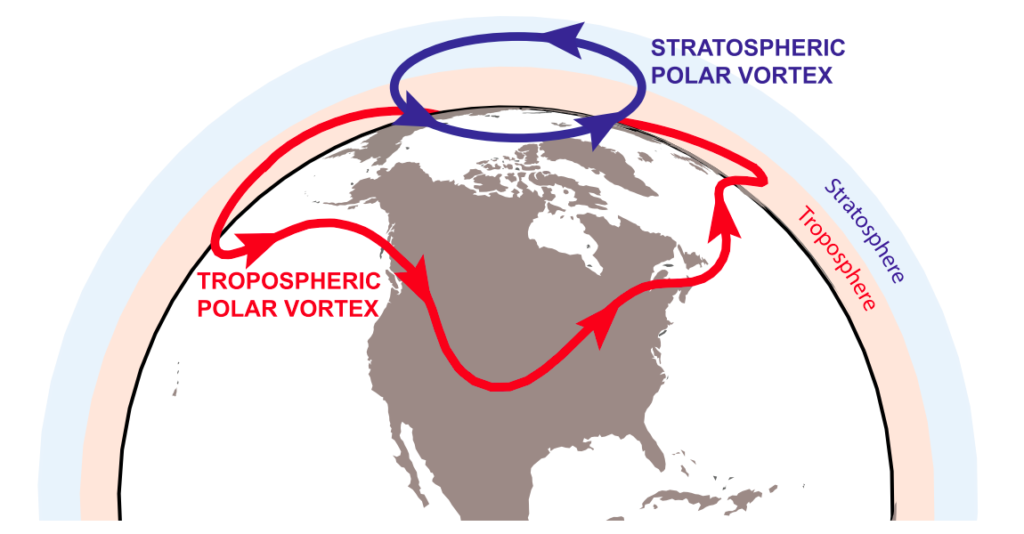
Illustration of the stratospheric (blue) and tropospheric (red) polar vortices. Source: Waugh et al. (2017). © American Meteorological Society. Used with permission.
As Screen pointed out earlier, the stratospheric polar vortex is often confused with a second vortex – this time in the troposphere.
The tropospheric polar vortex is a year-round feature of mid-latitude weather, driven by the temperature difference between the Arctic and the mid-latitudes. Its boundary winds are more commonly known as the jet stream. As seen in the illustration above, it is much larger than its namesake in the stratosphere.
The position and strength of the jet stream have a big impact on mid-latitude weather. When the jet stream is strong, its fast-flowing winds provides a barrier between the cold air over the Arctic and the milder air further south. When it weakens, the jet stream slows and can develop kinks. This allows the cold Arctic air to spill out into the mid-latitudes and for warmer air to spill in – as has been the case recently.
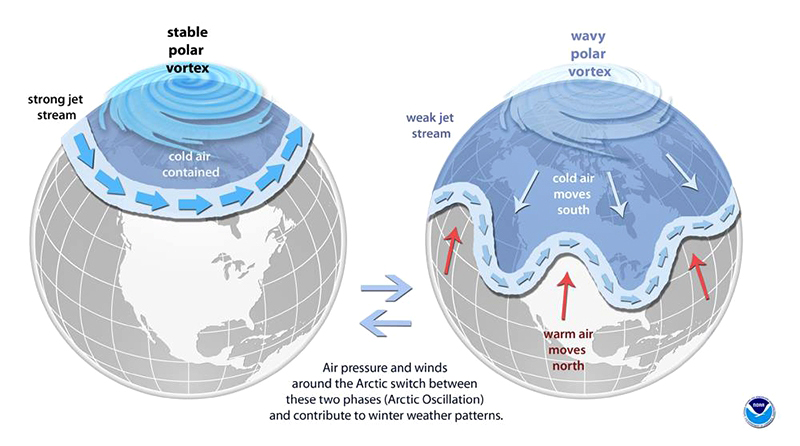
The science behind the polar vortex. Credit: NOAA
The strength and position of the jet stream can be gauged by a metric called the Arctic Oscillation (AO). When the AO is positive, the jet stream is strong. When it’s negative, the jet stream is weak.
The similar names and characteristics of the two polar vortices can cause confusion, says Screen:
“Typically, ‘polar vortex’ was reserved for the stratospheric, but now it seems ‘polar vortex’ is being used to essentially describe the jet stream”.
The distinction is important when it comes to talking about what has been happening to the weather this week and the potential impacts of climate change (more on that later).
Sudden stratospheric warming
The trigger for this week’s unusual weather started with a “sudden stratospheric warming” event.
Sudden stratospheric warming (SSW) occurs when something knocks the stratospheric polar vortex out of kilter. This can be caused by large weather patterns in the troposphere.
The resulting wobbles in the polar night jet can cause the circulation to slow down, reverse in direction and even split into two separate vortices. This allows air to collapse in over the Arctic, compressing the atmosphere and causing temperatures to rise dramatically in the stratosphere – by as much as 50C in just a couple of days.
When this happens, the knock-on impacts for the troposphere can mean the usual westerly winds that swirl around the mid-latitudes also reverse and become easterlies. This might take a few days or weeks to materialise.About two weeks ago, the stratospheric polar vortex weakened and then split into two. You can see this happen in the clip below. The fast-flowing winds shown by the purple lines wrench from neat single circle into two vortices swirling side-by-side.
What is being seen now is consequence of the split, explains Mottram:
“This has allowed warmer air to move up into the high Arctic Ocean and, at the same time, the remnants of the high pressure are now lodged over Scandinavia, bringing cold air to northern Europe and the Labrador Sea – so southwest Greenland is actually very, very cold and [Greenland’s capital city] Nuuk will probably have a below-average temperature this month.”
This is a classic weather pattern that occurs throughout the observed record, says Mottram. However, this time around, the pattern has been deeper and longer than normal, prompting the question of whether climate change is playing a part – particularly as research has shown an increasing frequency and duration of Arctic “winter warming events”, where daily temperatures peak above -10C.
Mottram says scientists do not yet have enough data about these events to say for sure whether these conditions are related to climate change, or that they will occur more frequently. However, such a warm Arctic could have had a helping hand, Mottram adds:
“It’s probably safe to say, though, that the warming associated with this event has been boosted by climate change to an extent. We see these warming spikes all the way through the record, but the baseline is shifting upwards. The atmosphere is warmer and so is the ocean.”
However, as well as background warming, some researchers argue that the rapid decline in Arctic sea ice is making extreme mid-latitude weather more likely.
Arctic amplification
Temperatures in the Arctic are increasing around three times as fast as the global average – a phenomenon known as Arctic amplification.
One of the main reasons is the loss of sea ice in the region. As Arctic sea ice melts, energy from the sun that would have been reflected away is instead absorbed by the ocean.
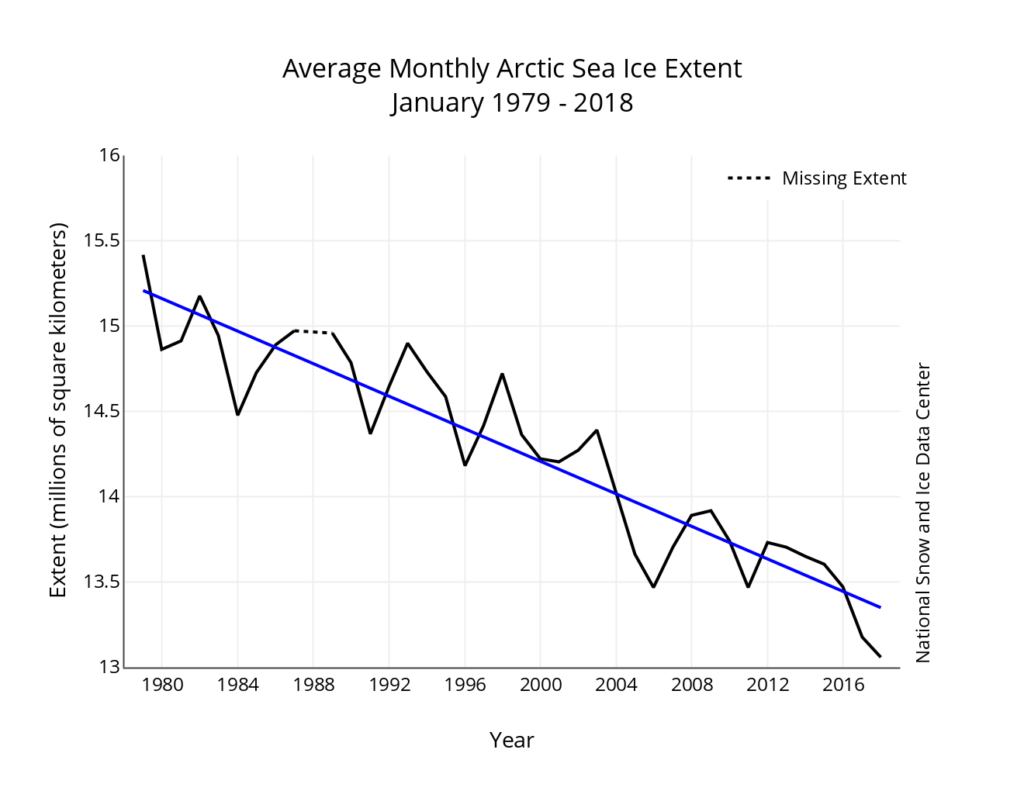
Monthly January Arctic sea ice extent for 1979 to 2018, showing a decline of 3.3% per decade. Note: the y-axis does not start at zero. Credit: NSIDC
The links between Arctic amplification and mid-latitude weather has become a prominent topic of climate research. Just last month, the journal Advances in Atmospheric Sciences published a special issue on the subject.
Scientists have put forward various mechanisms for how the two could be connected. For example, as the Arctic warms rapidly, the temperature difference between the Arctic and mid-latitudes declines. This could be weakening the jet stream, causing it to meander more and allow cold air to be pulled down to the mid-latitudes.
At the same time, some climate model projections suggest that while declining sea ice could amplify year-to-year variability in mid-latitude weather in the near-term, total variability will ultimately decrease under high emissions scenarios with major loss of summer sea ice.
The weakening of the stratospheric polar vortex is a possible route for Arctic amplification to influence mid-latitude weather, Screen explains:
“It has been argued that Arctic sea ice loss has weakened the polar stratospheric vortex and that this might make the negative AO [a weakened jet stream] and severe winters more likely.”
However, this theory is still “contentious”, he adds.
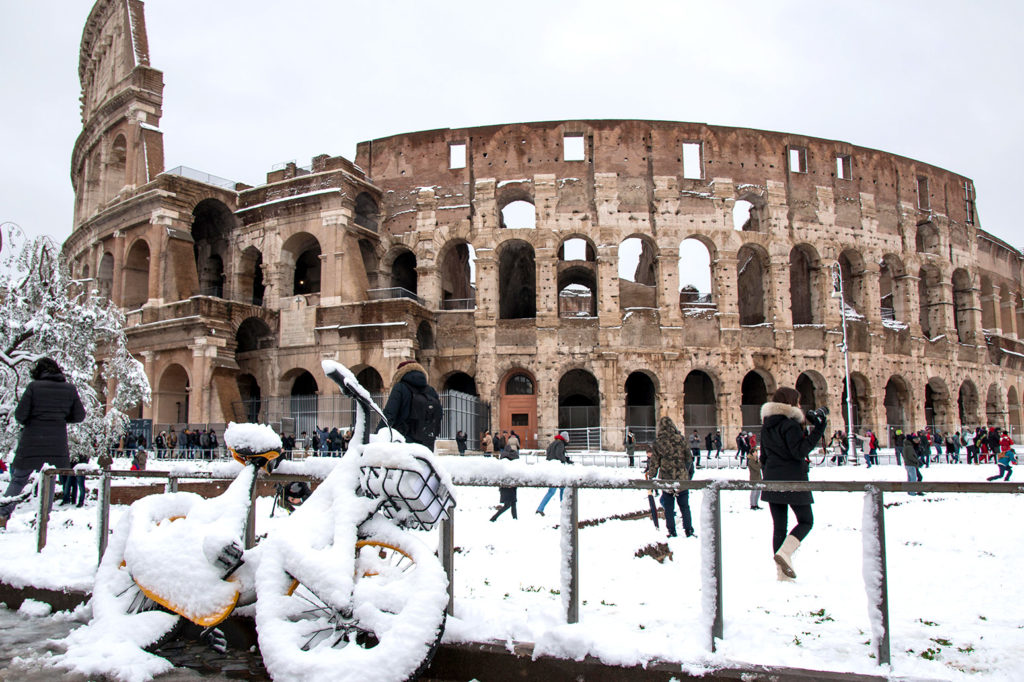
Roma, Italy. 26th Feb, 2018. People walk by the ancient Colosseum during a snowfall in Rome. Credit: CrowdSpark/Alamy Live News.
Other scientists are more certain. Prof Jennifer Francis, a research professor in the department of marine and coastal sciences at Rutgers University, tells Carbon Brief “there’s definitely a connection”:
“At least a dozen studies now have made the link between sea ice loss – especially in the Barents and Kara seas – to the jet stream into the stratospheric polar vortex and back to mid-latitude weather”.
The process starts with sea ice loss allowing Arctic waters to absorb more heat from the sun during summer, explains Francis. This warmth slows ice formation in the Barents and Kara seas in early winter.
There is usually a bulge in the jet stream over this region, says Francis. The warming creates an area of high pressure just to the east of the bulge, along with stronger cold winds from the Arctic going into central and eastern Asia, she explains:
“This effectively creates a larger north-south wave in the jet stream, which under the right conditions, transfers wave energy upward into the stratosphere. When large pulses of wave energy go into the stratospheric polar vortex, the vortex can be disrupted from its usual circular shape centered over the pole.”
This can, therefore, be the trigger for a sudden stratospheric warming event and, in turn, unusual weather in the mid-latitudes.
One of the studies that has made this link was published last month in the Bulletin of the American Meteorology Society (BAMS). Led by PhD researcher Marlene Kretschmerat the Potsdam Institute for Climate Impact Research (PIK), the study identifies seven different “states” that the stratospheric polar vortex displayed during winter (January-February) over 1979-2015.
Of these states, the frequency of a “weak distorted” vortex has increased from around three days per winter during 1979-96 to seven days during 1998-2015, the paper finds, while days of a “strong” vortex have declined from “from approximately 12 days per season to just six days”.
A weak vortex is usually “accompanied by subsequent cold extremes in midlatitude Eurasia”, the study notes.
In an earlier journal paper, Marlene Kretschmer’s research also identified sea ice cover in the Barents and Kara seas ice as “important external drivers” of mid-latitude weather patterns in winter.
But despite the flurry of work in this area, the “research in understanding the stratospheric pathway from Arctic Amplification and sea ice is still very young”, notes Zack Labe, a PhD candidate in climate science at the University of California at Irvine.
Indeed, there is “still significant research ongoing in understanding the dynamical relationships between stratosphere-troposphere interactions”, Labe tells Carbon Brief.
As such, for the time being, there is “not a clear consensus on how sea ice and Arctic amplification may affect the polar vortex”, he concludes.































 Arguments
Arguments





















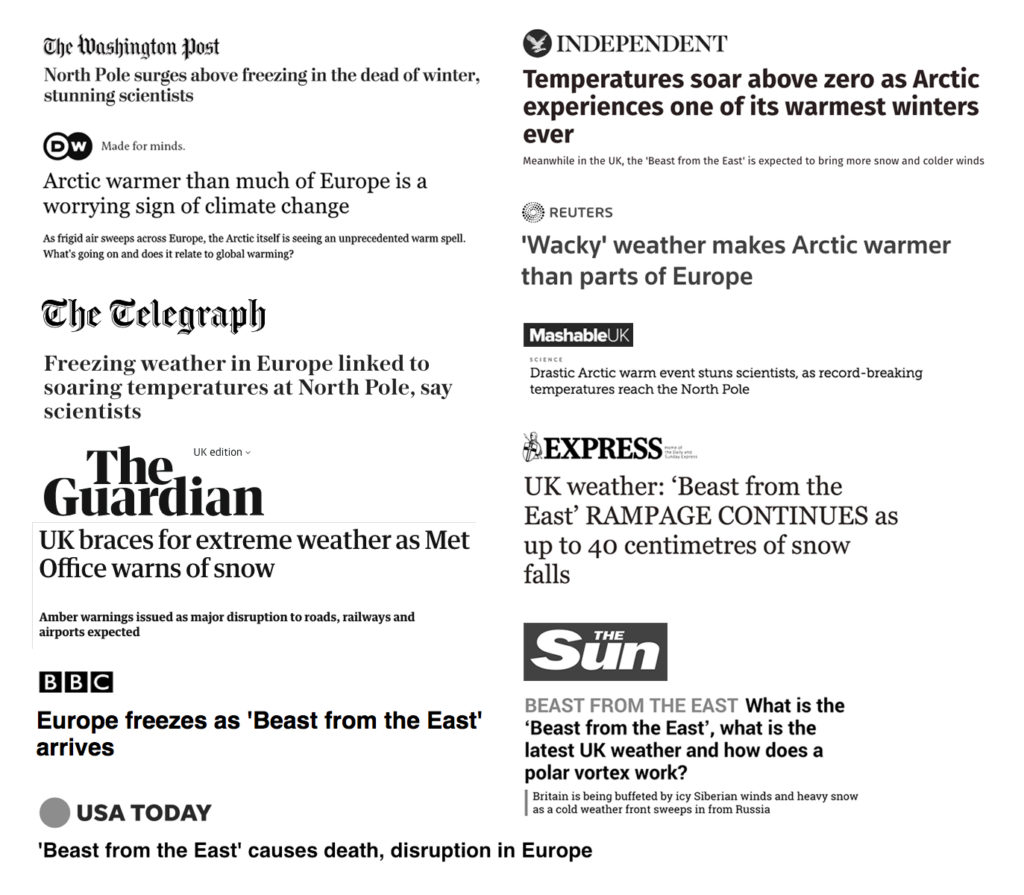
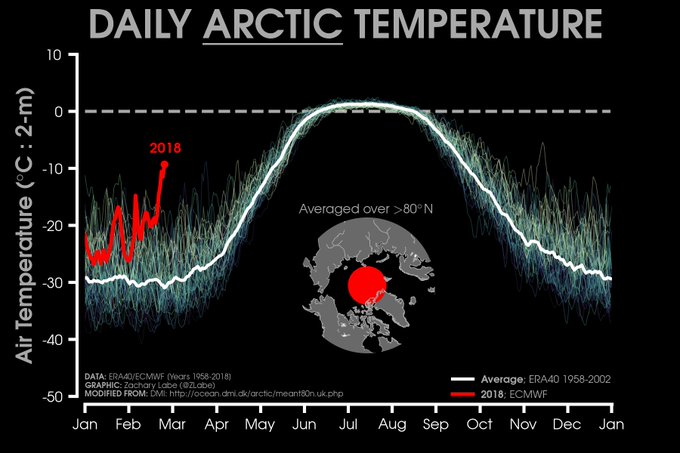

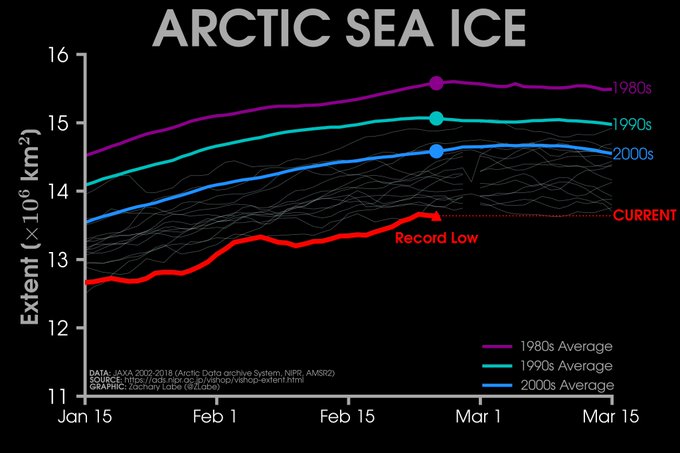
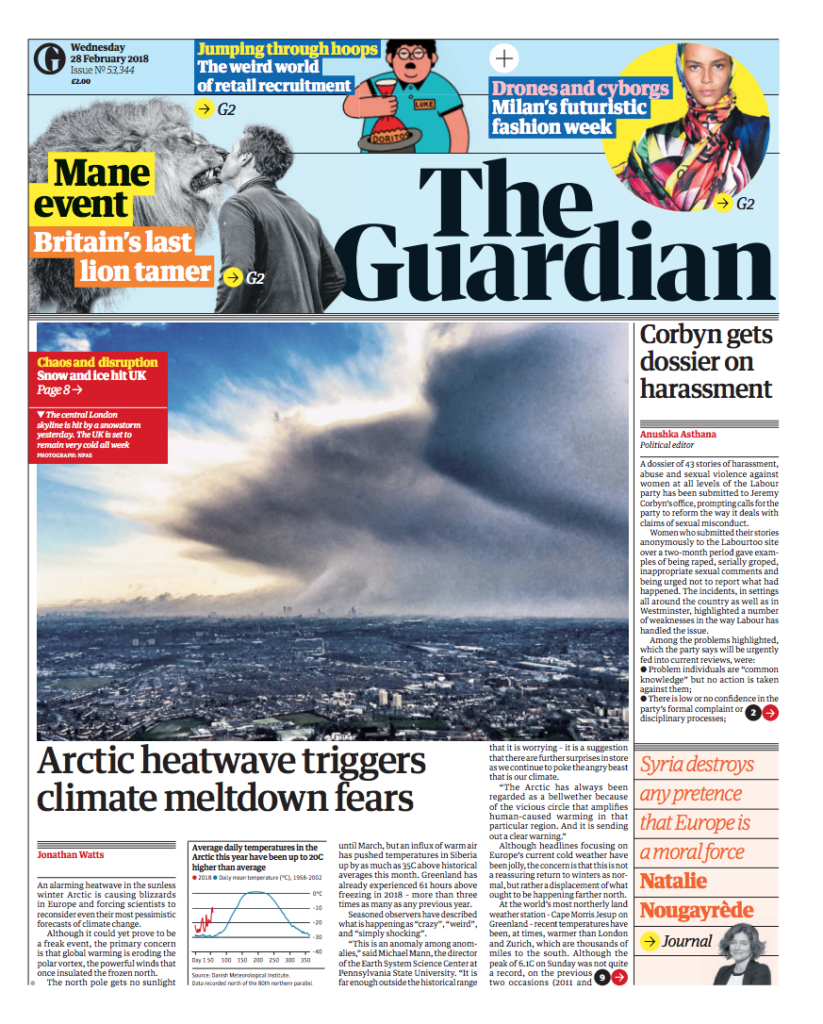
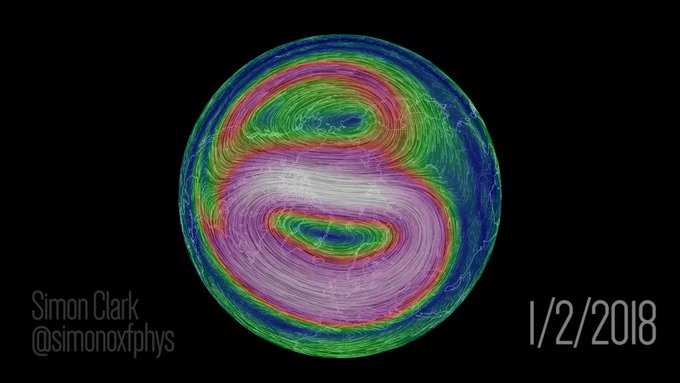









Thank's for that explanation. While It probably needs more time to be 100% sure, I think it would be stupid to underestimate or dismiss the scale of changes we are seeing in the arctic, and the implications for weather events.
A related thing is now happening in New Zealand but in reverse. NZ is currently experiencing what is likely to be its hottest summer on record. According to the article below this is due to a combination of climate change, a la nina weather event, and a positive phase of the SAM (southern annular mode) which is apparently a measure of the strength of the Antarctic polar vortex, and which tends to cause warm weather for NZ when in a positive phase.
www.nzherald.co.nz/nz/news/article.cfm?c_id=1&objectid=12000289
I'm not aware of the vortex splitting in two but the boundary winds are shifting and causing a warming effect.
According to the article, climate scientists have singled out climate change as being a big driver of an increasingly positive SAM. I'm on a bit of a learning curve with the details of the SAM, but I thought it was worth mentioning as it mirrors events in the arctic in some ways. Like with the arctic it may need more time to be 100% sure, but it would be very foolish to be complacent or dismissive.
I have a different take on the situation or rather a different way of thinking about it. When most of the Arctic is ice covered, as has been often stated, most of the solar energy is reflected back into space. The air over the arctic radiates heat into space, becomes heavy and sinks. As it hits the ground it spreads south and coriolis veers the moving air to the right resulting in the Polar Easterlies (moving toward the SW). Air, sucked in to the poles at high altitude is also veered to the right resulting in the mentioned counter clockwise circulation at high altitude. The air moving along the ground rises again at about 60 degrees north and heads back north at high altitude, completing the circulation of the Polar Hadley cell. Jet streams occur at the junction between Hadley cells and the northern jet stream occurs at the top of this rising wall of air between the Polar Hadley cell and the Ferrel Cell. It is this wall of rising air that separates polar air from temperate air and shepherds wether systems around the world.
As the Arctic Ocean warms due to more and more open water, we should see episodes of rising air over the Arctic. This should occur when the surrounding land is colder than the ocean. This will suck surface air northward and with Coriolis, will result in SW winds (flowing toward the North East). This will suck warm air into the Arctic. The climate zones which at present are creeping northward at about a mile per year can be expected to lurch northward. Two results, particularly are of concern. One is the disruption of our delicately poised grain growing belts in the Northern hemisphere. The other is the melting of Greenland. Latent heat from water to water vapor is roughly 6 times as large as from water to ice. If we have a coupling of rising moist air over the Arctic with density currents over Greenland, every liter of water that condenses on to the ice from this moist air can melt 6 liters of ice. Add to that the heating of the air as it flows down as much as 3km of slope and we could see some spectacular melting of Greenland in the not too distant future.
I have a question re the polar vortex and would be grateful for any responses. I have a climate denying relative who tells me that the recent shift in patterns of the polar vortex is a result of the sun which has just entered a solar minimum. Does this have any basis in fact? (I suspect not but would be interested in what people have to say on this). Thanks.
@Jonbo69
Lacking a physical mechanism to link solar output and the polar vortex is enough by itself to dismiss that conjecture outright.
Jonbo69 @3,
I would suggest there is a vast level of complexity in what you ask but it can be knocked into shape.
The complexities of Polar Vortex-Solar Minimum linkage has been utilised by some denialists to create anti-AGW messages. So, for instance, this post at denialist site TheHockeySchtick rests on three published papers which are not entirely relevant or conclusive or credible.
Such denialist posts are often response to messages linking intense cold snaps of winter to our planet's atmospheric circulations that are evidently being impacted by AGW. Thus the likes of this report of an AAAS meeting results in the deniosphere responding with the likes of this nonsense at the planet Wattsupia.
The complex variability of the Polar Vortex is in no way solely associated with solar output. Indeed, it is a relatively minor player. Thus Kim et al (2014) add the helpful concluding comment with solar activity the tail-end-Charlie of the list of possible factors:-
Linkage between Polar Vortex and Solar Minimum is more a subject of research (eg Maycock et al (2015), Chiodo et al 2016) because the regional impact of Grand Solar Minimums is missing from the standard climatological assessment. Yet these papers make no startling claims and are setting the solar-minimum-effects within future AGW which is probably why denialists wouldn't dream of touching them with a barge-pole.
Daniel Baily at 11 54 16 march
It appears that there is an explanation for the cold winters in western europe and it appars to be linked to sunspots, or their abscence
https://phys.org/news/2011-10-link-solar-winter-weather-revealed.html
Scientists have demonstrated a clear link between the 11-year sun cycle and winter weather over the northern hemisphere for the first time.
They found that low solar activity can contribute to cold winters in the UK, northern Europe and parts of America. But high activity from the sun has the opposite effect.
The study helps explain why the UK has been gripped by such cold winters over the last few years: the sun is just emerging from a so-called solar minimum, when solar activity is at its lowest.
'Our research establishes the link between the solar cycle and winter climate as more than just coincidence,' says Dr Adam Scaife from the UK's Met Office, one of the study's authors.
The findings, published in Nature Geoscience also raise the tantalising possibility that the regularity of the solar cycle might help weathermen predict cold winter weather over the northern hemisphere.
'We've been able to reproduce a consistent climate pattern, confirm how it works, and quantify it using a computer model. This isn't the sole driver of winter climate over our region, but it is a significant factor and understanding it is important for seasonal to decadal forecasting,' says Scaife.
Up until now, researchers have only managed to see a weak link between solar activity and winter weather: when the sun is less active, we're more likely to see weak westerly winds during the winter in the northern hemisphere. This pattern suggests that easterly winds could bring cold weather from the continent to the UK.
But scientists have struggled to incorporate these ultraviolet (UV) signals into climate models.
Now, new satellite measurements from NASA's Solar Radiation and Climate Experiment (SORCE) have revealed that differences in UV light reaching the Earth during the 11-year solar cycle are larger than previously thought. The satellite, launched in 2003, is the first ever to measure solar radiation across the entire UV spectrum.
Read more at: https://phys.org/news/2011-10-link-solar-winter-weather-revealed.html#jCp
Alchemyst, given your earlier comments expressing doubts about modelling, I am surprized at you pushing a modelling paper. I am a little curious as to how you found it but yet missed any the 2014 reviews of arctic influence. No matter – the paper in question (Ineson et al, 2011) was written showing some modelling support for hypothesis of low solar activity contributing to the then recent cold winters. The corollary of this view is that anomalous jet stream behaviour (present in those events) should have eased when the sun returned to active mode. It did not – anomalies continued right up to this year. Furthermore, if the solar is the dominant influence, (as opposed to a contributing factor), then the 2018 tree ring study of jet stream behaviour should be also revealing the link – it does not.
Overland et al 2015 has a discussion of arctic – jet stream linkages which I found very helpful. It notes solar (citing Ineson et al) among other possible influences (ENSO, QBO, AMO etc). However, the evidence is increasing pointing towards the loss of ice in the arctic basins as the dominant cause of recent anomalous jet stream variability. The tree ring study by itself put any "Its just a natural cycle" explanation in doubt.
Interestingly, the model effect from solar changes in Ineson et al affecting the jet stream variability is the decrease in equator-polar temperate gradient.
"This temperature change is directly attributable to the decrease
in ozone heating associated with ultraviolet irradiance, which
is important at these levels11. This signal peaks in the tropics
and corresponds to a relative decrease in the pole-to-equator
temperature gradient. This response is reproduced in our model
(Supplementary Fig. S1) with significant cooling of about 2 K near
the tropical stratopause. Geostrophic balance requires that the
diminished polewards temperature gradient is matched by a weak
easterly wind anomaly in the subtropical zonal mean circulation
in the upper stratosphere"
Sea-ice loss does exactly the same thing.
As this article clearly states, the science is still young but it certainly cannot be dismissed.
Not sure what planet the author lives on, record cold and snow with crop losses on this one.
[PS]
Please note that posting comments here at SkS is a privilege, not a right. This privilege can and will be rescinded if the posting individual continues to treat adherence to the Comments Policy as optional, rather than the mandatory condition of participating in this online forum.
Moderating this site is a tiresome chore, particularly when commentators repeatedly submit offensive, off-topic posts or intentionally misleading comments and graphics or simply make things up. We really appreciate people's cooperation in abiding by the Comments Policy, which is largely responsible for the quality of this site.
Finally, please understand that moderation policies are not open for discussion. If you find yourself incapable of abiding by these common set of rules that everyone else observes, then a change of venues is in the offing.
Please take the time to review the policy and ensure future comments are in full compliance with it. Thanks for your understanding and compliance in this matter, as no further warnings shall be given.
Note. Sloganeering, argumentive tone, offtopic, gish gallop. (Not to mention monumentally uninformed nonsense).
As more and more researchers look at the effects of the weakening polar vortex, we are now starting to see these types of cold snaps in TX.
More climate extremes ahead for Galveston County, experts agree
[BW] Corrected the broken link